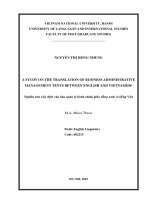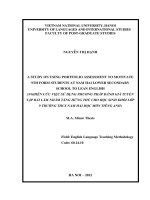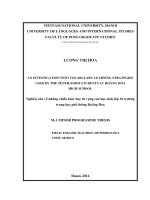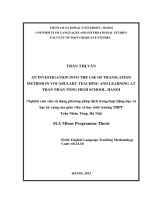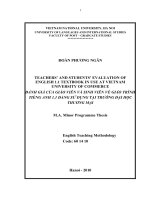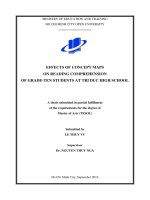A STUDY ON THE USING OF COOPERATIVE LEARNING IN DOING PROJECT ASSIGNMENTS OF GRADE 10 STUDENTS AT CAM KHE HIGH SCHOOL Nghiên cứu việc sử dụng phương pháp học hợp tác trong phần Dự án của học sinh lớp 10 Trường THPT Cẩm Khê.
Bạn đang xem bản rút gọn của tài liệu. Xem và tải ngay bản đầy đủ của tài liệu tại đây (1.52 MB, 92 trang )
1
ACKNOWLEDGEMENTS
I am deeply indebted people whose help to make my graduation paper
possible.
First and foremost, I would like to express my deepest thanks to my
supervisor Ms. Nguyen Thi To Loan, M.A, whose invaluable comments,
guidance, criticism and generous help were very important to me in the process
of carrying out this study.
My special thanks also go to all lecturers and the staff of the Faculty of
Foreign Languages at Hung Vuong University for their useful materials,
guidance and enthusiasm during my course of study.
I really wish to thank all of my colleagues and my students at Cam Khe
high school for their enthusiasm participating in doing the questionnaires.
Without their valuable opinions and ideas on the questionnaires, the study would
not have been accomplished.
Last but not least, I would also like to show my deep gratitude to
my beloved family and my friends who always support and stand by me with
their consideration and encouragements.
2
ABSTRACT
In upper-secondary schools in Vietnam, with the innovation of textbook
for 10th form students in light of Communicative Approach, the teaching of the
four skills has been much more focused on. So far, the English teaching methods
have been on the way to perfect. However, in doing project assignments is a
crucial lesson that the teachers of English experience a lot of difficulties. In
order to improve the quality of doing project writing, the graduation paper limits
itself to the study on using cooperative learning in doing project assignments for
10th students. This study is to bring some effectiveness to the process of doing
project in the classroom.
The study has been conducted for the purpose of investigating the real
situation of using cooperative learning in doing project assignments to improve
in project lesson of grade 10th students at Cam Khe high school, Phu Tho
province. Thus, two sets of survey questionnaires are used to investigate
student’s attitudes, perspectives toward in doing project and cooperative learning
in project to find out the teachers’ difficulties in carrying out this technique.
From the results collected from the survey questionnaires and teacher’s
interview, the researcher recommended some solutions to deal with the
cooperative learning and improve the students’ project performance. The results
showed that the use of cooperative learning in doing project assignments are an
effective way to improve doing project assignments for high school students.
This is also the researcher’s wish to have a suitable and interesting method in
teaching project to help grade 10 students at Cam Khe high school improve
project assignments.
Hopefully, the graduation paper will make a small contribution to the
improvement of learning and teaching in general and in doing project
assignments in particular.
3
TABLE OF CONTENTSContents
4
LIST OF ABBREVIATIONS
CL
Cooperative learning
PBL
Project Based-Learning
CLT
Communicative Language Teaching
EFL
English as a Foreign Language
ELT
English Language Teaching
ESL
English as Second Language
%
Percent
5
LISTS OF TABLES AND FIGURES
NO
Table
Page
1
Table 1.1: Distinguishing cooperative learning from
16
2
traditional groups
Table 1.2: The contents and structure of units in Textbook
25
3
English 10
Table 1.3: Checklist of project in current “English 10”
26
4
Textbook
Table 2.1: The English entrance examination scores of
28
5
grade 10A4
Table 2.2: Summary of the students’ questionnaires
30
6
Table 2.3: Summary of the teachers’ interview questions
30
7
Table 2.4: The experiment procedure at Cam Khe High
32
8
school
Table 3.1: Students’ understand doing project assignments
34
9
Table 3.2: “What students know about the CL
37
10
Table 3.3: Students’ opinion about “the benefits of CL”
37
11
Table 3.4:Students’ expectations in using CL in English
38
12
lesson
Table 3.5: Benefits of CL in doing project
41
13
Table 3.6: Students’ difficulties in CL method
42
14
Table 3.7: Students’ expectations of using CL in doing
43
project
NO
1
Figure
Figure 3.1: Student’s attitude before using of CL in doing
Page
35
2
project (%)
Figure 3.2: Students’ feeling in doing project assignments
36
3
difficult (%)
Figure 3.3: Students’ attitudes towards doing project
40
4
assignments (%)
Figure 3.4: Students’ feeling about CL in doing project
41
5
assignments (%)
Figure 3.5: Students’ opinion about necessary CL in doing
42
6
6
project (%)
Figure 3.6: The frequency of using cooperative learning in
doing projectThe frequency of using group writing (%)
43
7
PART I: INTRODUCTION
1. Rationale
Recently, cooperative learning (CL) has been a proper solution to enhance
learner’s performance. It has been widely believed that there are some sound
reasons to take CL into implementation but not other methods. Obviously, as
one of the most popular structures of learners-centered approach in the recent
years, cooperative activities have been widely used in language classroom,
especially in encouraging learner’s participation and improving their motivation
in learning. First, CL is highly appraised for their contribution to student's
achievement. It is beneficial both for academic achievement and the
development of the learners social and learning skill. Second, CL has a rigorous
foundation on research. Studies have been conducted and come to a conclusion
that CL are associated with achievement, high thinking level, self esteem, liking
for the subject matter, for schools and the intergroup relations. Furthermore,
many studies have proved that cooperative learning has positively influenced
students’ project-based learning (PBL) performance (William, 2003; Noel &
Robert, 2003; Graham, 2005). CL has enormous advantages over traditional one
because traditionally, students only communicate with the teacher about their
learning but in CL classrooms students are involved in group work and
discussions, which not only improves doing project assignments accuracy but
also betters their problem solving skills as well as establish a social atmosphere
and meaningful learning.
However, the real situation is always different from theory. According to
my observation, many students at Cam Khe High School find project a difficult
task, they find project hard to do, they only deal with tasks in class and they
don’t often learn at home. Moreover, most teachers often skip this part because
they found difficult to design classroom activities to attract students’
participation. They encounter lots of challenges in finding appropriate methods
8
to learn this part. And they often ask students to finish this part at home without
checking what their students had done. Obviously, students themselves often
neither study at class nor at home. One of the difficulties of students when
learning in doing project because this is a difficult task to them and it is absolute
new to them.
Moreover, despite the benefits of CL, there is still inadequate research on
the issue, especially in the context of Vietnam. Similarly, at Cam Khe High
School, there has been no research on the subject of improving students in doing
project by cooperative learning. For this reason, the researcher decided to carry
out a research on “A study on the using of cooperative learning in doing
project assignments of grade 10 students at Cam Khe High School”
2. Previous researches
2.1. In the world
Ahangari and Samadian (2014)conducted a study about “The effect of
cooperative learning activities on writing skills of Iranian EFL learners”. 50
students of Islamic Azad University were selected for their experimental study.
The outcomes of the study confirmed the effect of cooperative learning activities
on improving the components of writing skills such as content, organization,
vocabulary, language use and mechanics. The researchers suggested that writing
performance can be improved through small-group cooperative interaction
among peers in a supportive and stress-reduced environment.
Ilhan Ilter (2014) also had a study on “The efficacy of project-based
learning approach on Social Studies Education: Conceptual achievement and
academic motivation.” In this research, an experimental study was carried out in
social studies 4thgrade students' to develop students' conceptual achievement and
motivation to succeed academically. The study aims to investigate the
effectiveness of project-based learning (PBL) in social studies. The findings
indicated a statistically significant difference in favor of the experimental group
on the concept achievement and motivation. Students who participated in the
9
PBL environments not only enriched and expanded their knowledge but also
achieved a higher level of motivation than the control group. The PBL in team
format activities were provided to promote the experimental group students'
motivation to succeed academically and to develop their conceptual
achievement. The results demonstrated that the PBL improved students'
understanding regarding social studies concepts and helped them achieve the
behaviors which were aimed academically. The experimental group's intended
behaviors in academic motivation at the beginning of the experimental treatment
turned into performed behaviors at the end.
2.2. In Viet Nam
The study titled “ The effects of cooperative learning activities on
improving writing skills of EFL students at International school, Vietnam
National University a quasi experimental research” of (Tran Thi Lan Huong
2013) was conducted as an attempt to examine the perceptions of first-year EFL
learners towards CL to investigate their participation level and quality in CL,
find out possible influential factors on their participation, pinpoint teachers’
monitoring strategies to motivate students to participate in activities, and
recommend several pedagogical implications to motivate and balance their oral
participation.
The study titled “The Effect of Project-Based Learning on Student
Performance” by of ( Nguyen Thi Huyen Trang (2016 ) This study analyzed
the effectiveness of an alternate pedagogical approach in the form of standardsfocused project-based learning (PBL) teaching model in psychology classes.
Both the control and experimental groups initially adopted a negative attitude
when presented with an alternate method of learning. They viewed the group
project as an unnecessary task although the literature contradicts their initial
perception. Data analyzed found that the experimental group that engaged the
project and took responsibility for the learning of their peers scored significantly
higher on the multiple-choice exam when compared to the control group. No
10
significance was found in the second experimental group where majority of the
students did their part, but did not report feeling a sense of responsibility for the
learning of their peers. Key indicators for higher academic performance were: 1)
high self-efficacy; 2) high level of perceived control; and 3) growth mindset.
This is the first time the study “A study on the using of cooperative
learning in doing Project assignments of grade 10 students at Cam Khe High
School” is carried out in Cam Khe district. Different from other studies, it
focuses on studying CL in teaching and doing project assignments whereas the
above studies focus on different aspects.
3. Research purposes
The study aims at:
- Investigating the current situation in of teaching and learning “Project” part
in English 10 textbook at Cam Khe High school.
- Applying CL in teaching “Project” part in English 10 textbooks.
- Evaluating the effectiveness of CL in teaching “Project” part in textbook for
grade 10 students.
- Proposing some suggestions to improve CL activities for teaching and learning
project of grade 10 students at Cam Khe High school.
4. Research questions
In order to achieve the above-mentioned purposes, the study seeks to answer
the following questions:
1. How is “Project” part in English 10 textbooks is being implemented at Cam
Khe High School ?
2. How isto apply “ Cooperative learning” applied in doing “Project” part in
English 10 textbooks?
3. Is that activity effective in enhancing student’s performance in doing
project?
5. Methodology
11
5.1. Research methods
In order to accomplish this graduation paper systematically and
adequately, the quantitative and qualitative methods were used.
In the quantitative methods, two survey questionnaires were used to collect
information and evidence for the study:
-The survey questionnaires were for 42 grade 10 students at Cam Khe High
school.
At the same time, in the qualitative method, two teachers’ interviews were used
to help the author confirm the results got from the survey questionnaires.
5.2. Research procedure
The research has been done with the following steps:
- Firstly, identify the rationale of the study by using the related documents to
give background of CL, doing “project” assignments and their related aspects.
- Secondly, study the current situation in doing project lessons for grade 10
students at Cam Khe High school.
- Thirdly, find out the effectiveness and difficulties when using CL in doing
project assignments.
- Lastly, propose some solutions in using CLfor grade 10 students in doing
project assignments based on the real situation.
56. Significance of the study
Although the study was conducted on a small scale with a particular
group of grade 10 students at Cam Khe high school, the researcher hoped that
its findings could be of great significance. This study is a contribution to an
understanding of the applicability of the cooperative learning to the teaching of
English in general and the teaching of projectwriting for academic purposes in
particular in the context of a Vietnamese high school. Besides, the findings of
the study will make a small contribution to the improvement in using CL in
doing project assignments of teachers and students of English in general and
those of Cam Khe High school in particular. In addition, the research also helps
12
the teachers and students apply CL more effectively, which may make doing
project assignments lessons more interesting, and students’ presenting skills are
hopefully improved.
67. Scope of the research
Due to time constraints, instead of studying the current situation of using
cooperative learning activities in a larger context, this study only focuses on
applying cooperative learning in doing project assignments for 42 students of
grade 10A4 at Cam Khe High school. Moreover, in this paper, due to the lack
of time and effort, I would solely discuss the use of CL in doing project
assignments, not the other parts of the lessons to determine its effectiveness
more clearly in the small context of grade 10 students at Cam Khe High
school.
78. Design of the research
The research consists of three parts.
Part 1: Presents the overview of the study including the rationale for the
research,
previous
researches,
research
purposes,
research
questions,
significance of the research, the scope of the research as well as the structure of
research.
Part 2is sub-divided into four chapters:
Chapter 1 is the literature review. In this chapter, the literature on
cooperative learning and doing project are stated.
Chapter 2 focuses on the subjects of the study, discusses the instruments
and presents the data collection, analysis and research procedures.
Chapter 3 in which the current situation in applying cooperative learning
for grade 10 students at Cam Khe high schoo l lare provided.
Chapter 4 focuses on giving some major findings of the study and
suggesting some techniques for better using CL for grade 10 students in doing
project assignments.
13
Part 3 summarizes the study. Also in this part, the implications for
classroom practice, the limitations of the study and suggestions for further
studies are clearly presented.
In a nutshell, this part has presented the background, and significance of
the study. These contribute to the purposes and the research questions of this
study in teaching and studying doing project assignments at Cam Khe High
school. The present study also provided the scope of the study. An outline of
this study was given in the last of this part.
PART 2: CONTENT
CHAPTER 1: THEORETICAL BACKGROUND
14
The purpose of this chapter is to provide information pertaining to this research,
which was obtained from reviewing the related literature and studies.
1.1. An overview of cooperative learning
1.1.1. Definition of cooperative learning
Since cooperative learning has recently drawn much interest and becomes
popular, a number of researches have been done to investigate the effectiveness
of this approach of teaching. It is beneficial to discover the definition of the term
cooperative learning (CL) to gain a more comprehensive understanding of the
approach. In general, CL is a strategy for group instruction which is under the
learner-centered approach. In detail, CL is ‘'an instructional program in which
students work in small groups to help one another master academic content.
They are a team whose platers must work together in pairs or groups to achieve
the goals successfully" (Brown, 2002).
In language learning contexts, CL is defined as within-class grouping of
students usually of different level of foreign language proficiency who learn to
work together on specific tasks for projects in such a way that all students in the
group benefit from the interactive experience. Students work together to
maximize their own and each other’s learning. According to Johnson and
Johnson (2005), CL is a teaching strategy in which small teams use a variety of
learning activities to improve their understanding of a subject, each member is
responsible for learning and helping classmates until they all understand and
complete the assigned task.
According to Stahl (2006), during the past decade, cooperative learning
has emerged as the leading new approach to language teaching. Numerous
research have revealed that CL tends to enable to achieve higher academic test
scores, higher self-esteem, greater numbers of positive social skills, greater
15
understanding of the content and skills they are studying. CL is especially
beneficial to language learners due to the fact that they are provided
comprehensive input m appropriate ways and in a supportive and motivating
environment (Kagan 2008). Additionally, Olsen and Kagan report some benefits
of the strategy-for language learning. First, in traditional classrooms, teachers
give students little time to produce language, especially weak students. On the
contrary, in cooperative classes, most of class tune is devoted to students ’
activities, and then they have many of chances to produce language, resulting in
their activeness and better communication. Furthermore, CL impacts positively
on language acquisition because small groups enrich language classroom with
comprehensible and accurate input. To sum up, as CL enhances language
development and the learning of concepts and contents, assigning students to
different groups is necessary for them to benefit more from English language
role models.
In conclusion, cooperative learning is an approach to group work that
minimizes the occurrence of those unpleasant situations and maximizes the
learning and satisfaction that result from working on a high-performance team.
A large and rapidly growing body of research confirms the effectiveness of
cooperative learning in higher education. Relative to students taught
traditionally with instructor-centered lectures, individual assignments, and
competitive grading cooperatively taught students tend to exhibit higher
academic achievement, greater persistence through graduation, better high-level
reasoning and critical thinking skills, deeper understanding of learned material,
greater time on task and less disruptive behavior in class, lower levels of anxiety
and stress, greater intrinsic motivation to learn and achieve, greater ability to
view situations from others’ perspectives, more positive and supportive
relationships with peers, more positive attitudes toward subject areas, and higher
self-esteem. Another nontrivial benefit for instructors is that when assignments
16
are done cooperatively, the number of papers to grade decreases by a factor of
three or four.
1.1.2. Benefits of cooperative learning in language education
CL is a good way to maximize learners’ academic achievement as well as
their social skills. Especially, highly structured CL enables them to improve their
own apprehension of the key materials while developing good relationship with
peers by encouraging and assisting them.
Firstly, according to Gillies & Ashman( 2003), the most obvious benefit
of CL for students fells into academic achievement. Most of the researches
conducted into the effectiveness of CL have positive findings. CL activities
supply learners with structured chances to collaborate to reach the common
goals in language acquisition. They help each others to benefit from their
contribution to the learning process. Working in groups enables learners to
provide each other with information, suggestions, reminders and motivation.
They not only achieve better results, develop their thinking and leadership skills
but also enjoy their learning with positive views towards other learners, good
self-esteem and a sense of belonging to a group.
Graham (2005)& Gillies & Ashman ( 2003), CL strategy was found to be
useful for both language education and other aspects such as motivational and
communicative activities, good relationship with participants and stress
overcoming.
Moreover, according to Gabriele (2007), in CL classrooms, lower students
learn much from strong partners because when working individually they may
get stuck, but collaborating with better students enable them to understand the
materials more easily.
In the second place, according to Graham(2005),cooperative learning
betters students socially and emotionally. CL helps learners to become better
communicators and listeners, cooperative members as well as effective leader of
17
a team. Besides improving social skills, CL also develops personal competence
of self-reflection and accurate self-assessment. By working closely with
classmates, learners can assess their own strengths and weaknesses, know how
to make use of the diversity to reach the common goals. In other words,
cooperative learning encourages students to become reflective practitioners and
strive for continuous improvement. Furthermore, CL is also considered an
effective remedy for educational problems by not only helping to improve
academic results but also encouraging learners to become involved in social and
academic settings. It also has good impact on the problem solving ability of
children.
According to William(2003), Children of lower ability who completed
their work collaboratively with peers of higher ability had significant
improvement m their performance. In addition, learning cooperatively enables
learners to communicate with each other, which gives them opportunities to talk
together about their work socially and collaboratively. Discussion with peers is
also a good way to make writing more meaningful and apparent and helps
learners to become able to read their work critically.
1.1.3 Key elements of successful cooperative learning
Johnson, Johnson & Holubec (1993), Johnson & Johnson (2005), CL can
only be more produce competitive and individualistic efforts under certain
conditions. There are five basic elements of successful cooperative as follows:
1.1.3.1 Positive interdependence
According to Johnson, Johnson & Smith (1998), group members
understand that they need each other to fulfill the assigned tasks so they will
contribute to the learning of group actively. This element is the heart of CL
because the nature of CL is die improvement and maintenance of positive
interdependence among team members. Students need to do activities in which
18
they learn to depend on each other as they get help from one another. Instructors
may structure positive interdependence by establishing mutual goals to
maximize own and each other’s productivity, giving joint rewards, for example
if all members achieve above the criteria each will receive bonus points, sharing
resources with members’ different expertise and 'assigning roles of summarizer,
encourager or elaborator. As a result, teamwork will help them learn valuable
skills which will benefits them vocationally and socially.
1.1.3.2 Face-to-face interaction
According to Me Groarty (1993), academic and language learning
requires that students have opportunities to understand what they hear and read
as well as express themselves in meaningful tasks. Interaction is the second
element of CL because cooperative learning makes natural demand for
communication in which students have to listen to one another ask questions
clarify issues and restate points of view. Students are engaged in high level
thinking skills such as analyzing, explaining, synthesizing and elaborating
through cooperative learning. These interactive experiences are extremely
valuable for students who are learning English as a second language because
they naturally stimulate- and develop the students’ cognitive, linguistic and
social abilities. Thus, students should be taught and reinforced about the way to
interact effectively with others. They gradually get to know and trust one
another through teambuilding activities. Accepting and supporting one another
and resolving conflicts constructively are other useful skills students attain when
doing CL tasks. Also, teachers need to model positive interpersonal skills, get
students practice the skills as well as encourage them to process the
effectiveness of their performance. Focusing on social skill development will
increase
student’s
achievement
and
enhance
students’
employability
interpersonal relationships and general psychological health (Johnson and
Roger, 2005).
1.1.3.4. Individual accountability
19
Jollise (2007) mentions that each group member is accountable for
fulfilling his or her part of the work. Each student needs to develop a sense of
personal responsibility to leant and help the rest of the group to learn also.
According to Stahl (1994), the reasons why teachers put students in CL
groups is all students can achieve higher academic results individually than
when they study alone. Consequently, each student must be held individually
responsible and accountable for doing his or her own share of the work and for
learning what has been aimed to learn.
1.1.3.5. Social skill
Johnson and Holubec (1993)points out those groups cannot function well
if students do not have and use the needed social skills such as leadership,
decision-making, trust- building, communication, and conflict-management
skills. For the cooperative learning environment and precisely as academic skills
and the learner should utilize the skills they have learnt in completing assigned
activities.
Stahl (1994)asserts that students are placed in groups and expected to use
appropriate social and group skills does not mean students will use
automatically use these skills. In order to work as a group, students need to learn
to cope with leadership, trust-building, encouragement, compromise and
clarifying. Teachers need to describe expected behaviors and attitudes as-well as
assign students roles to make sure that consciously work on these behaviors in
their groups.
1.1.4 Distinguishing cooperative learning from traditional groups
According to Johnson and Johnson (2005), group learning only puts
students to sit and group without further assistance and careful structure to make
group work become teamwork; whereas cooperative learning goes strictly with
five elements including positive independence, individual accountability, quality
20
group processing, explicit teaching of small group skills and teaching of social
skills.
The table below is provided to help differentiate between traditional and
cooperative learning groups (Srinivasa & Pujari, 2013)
21
Table 1.1. Distinguishing cooperative learning from traditional groups
Criteria
Cooperative
Traditional
Learning
Positive -
-
interdependence
with
interdependence.
structured - Focus is on
goals.
Interdep endence
individual
Each
member
that
Groups
No positive
group performance
believes only.
they
cannot -
Assignments
succeed unless the are
discussed
other members of with
the group succeed.
commitment
- Group members each
help,
little
to
other’s
assist, learning.
encourage,
and
support each other's
efforts to learn.
A
clear accountability
Account
ability
individual’s
No
of accountability of
share individual’s
of the group’s work share
of
through
role group's work.
assignment
and
the
regular rotation of
assigned roles.
-
Members
self
and
accountable
hold
others
for
high quality work.
-Heterogeneous
-Homogeneous
22
Heteroge ability
neous
assigned
ability
teachers.
-
grouping ability grouping
by and
little
attention
to
group formation.
of - Few being
Sharing
leadership roles.
appointed to be
Leaders
in charge of the
hip role
group
or
person
often
one
'
takes charge' and
does
all
the
work.
- Sharing of the - Each learner
Responsi appointed learning not
bility
tasks
for
others'
learning
to - Focusing
-Aiming
Learning maximize
responsible
on
each assignment
focus
member's learning
accomplishment
Working - Maintaining good Frequent
relations working
hip
neglect
relationship,
working
process- oriented
relationship,
of
product-oriented
- Teamwork skills - Assuming that
Focused
skills
are emphasized
students
have
Members are taught already required
and expected to use skills
collaborative skills.
Teacher’s Teacher’s - Little teacher's
observati
on
observation
of observation
learners’ interaction
-Structuring of the - Rare structuring
procedures and time of the procedures
23
Procedur for the processing
es and
time
and time for the
- Students are provide processing.
time and a procedure - No processing of
to examine how their how
well
teams are working, group
how
applying
they
the
is
are functioning or the
suitable quality of its work.
communicative skills,
and how to better the
quality of their task
together.
1.1.5 Limitations of cooperative learning
According to Kagan (1995), most of the limitations of CL might come
from not implementing cooperative structure carefully. Though CL has been
widely appreciated and recommended for teaching, it is not a complete teaching
method which can solve all educational matters. If the teacher just arrange
students into groups and did not structure die positive interdependence and
individual accountability, it may be easy to see that one learner takes charges
and does all the work or an aggressive student does not allow others to
participate. Second, CL is also regarded to be time-consuming, especially in the
very beginning of the process when CL is still something new to both the teacher
and students.
Moreover, teachers who want to carry out CL may encounter the hostility
and objection from students who think that they are held back by weaker and
less confident students and even some think that they are ignored by their team.
Also, some other research findings have shown negative effects of implementing
CL in teaching writing such as students feeling reluctant to work in groups
24
(Storch, 2007) or not reducing learners' anxiety and apprehension when writing
(Murray, 1994).
However, the above short-comings of CL can be minimized or even
avoided if the teacher experiences continuous teacher- development and pays
attention to structuring the group carefully before implementation.
1.2. Overview of doing project assignments
1.2.1. Definition of project
Project is described by many definitions. Every of these definitions
contain solution of a problem by the group of students. And the work of students
is commonly ended by the creation of some product, what can be thesis, report,
design plan or model. Students activity takes a considerably length of time and
there is a presence of variety of educational activities.
According
to
Jones,
Rasmussen,
&
Moffitt,
(1997)
Thomas,
Mergendoller, & Michaelson, (1999) project is a model that organizes learning
around projects. According to the definitions found in project handbooks for
teachers, projects are complex tasks, based on challenging questions or
problems, that involve students in design, problem-solving, decision making, or
investigative activities; give students the opportunity to work relatively
autonomously over extended periods of time; and culminate in realistic products
or presentations.
According to Blumenfeld (2009), the essence of project is that a question
or problem serves to organize and drive activities; and these activities culminate
in a final product that addresses the driving question. Project is an instructional
method centered on the learner. Instead of using a rigid lesson plan that directs a
learner down a specific path of learning outcomes or objectives, project allows
in-depth investigation of a topic worth learning more about . Through the
construction of a personally-meaningful artifact, which may be a play, a
multimedia presentation or a poem, learners represent what they've learner. In
25
addition, learners typically have more autonomy over what they learn,
maintaining interest and motivating learners to take more responsibility for their
learning. Project and the construction of artifacts enable the expression of
diversity in learners, such as interests, abilities and learning styles.
Project is a method for imparting thinking competencies and creating
flexible learning environment. Project has a nature of exploring new areas,
discovering new scientific issues and integrating knowledge from different
subjects. The concept of project has a certain similarity with the notion of
knowledge building. These authors define ‘‘learning’’ as an activity that is
directed to improve mental structures, whereas ‘‘knowledge building’’ is
directed at improving knowledge objects such as explanations and models.
Project can be described as involving both vertical learning (i.e.,
cumulating of subject matter knowledge) and horizontal learning (i.e., generic
skills such as project management).
1.2.2. Definition of Project- based learning (PBL)
Thomas Markham (2011) describes PBL as: "PBL integrates knowing and
doing. Students learn knowledge and elements of the core curriculum, but also
apply what they know to solve authentic problems and produce results that
matter. PBL students take advantage of digital tools to produce high quality,
collaborative products. PBL refocuses education on the student, not the
curriculum a shift mandated by the global world, which rewards intangible
assets such as drive, passion, creativity, empathy, and resiliency. These cannot
be taught out of a textbook, but must be activated through experience”.
According to James G. Greeno (2006), PBL is a comprehensive
perspective focused on teaching by engaging students in investigation. Within
this framework, students pursue solutions to nontrivial problems by asking and
refining questions, debating ideas, making predictions, designing plans and/or
experiments,
collecting
and
analyzing
data,
drawing
conclusions,

